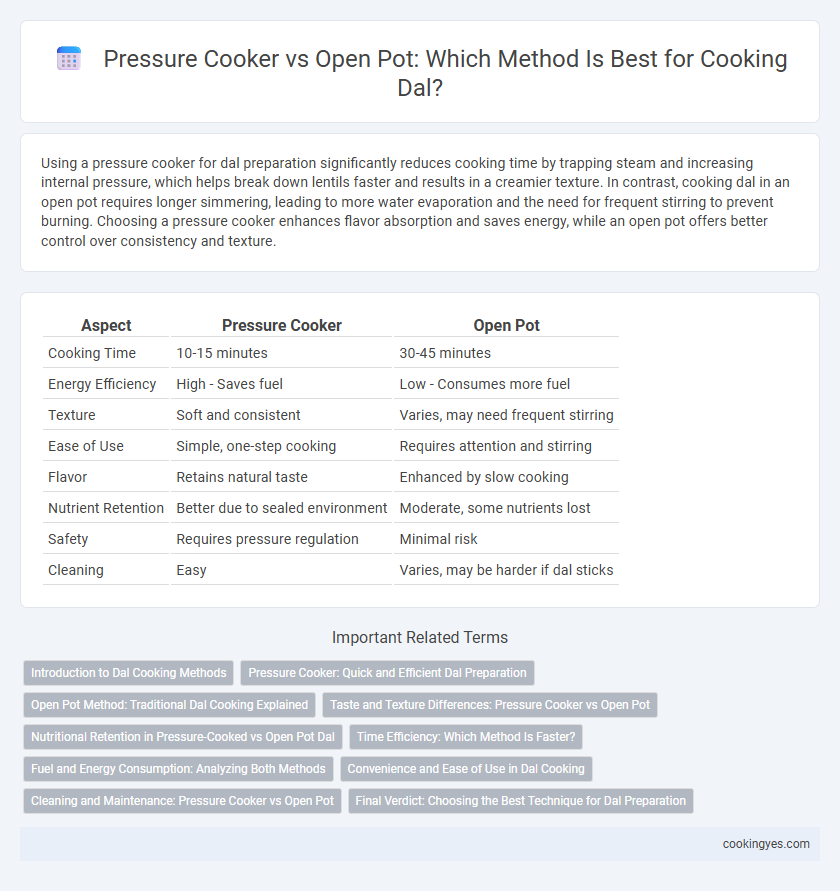Using a pressure cooker for dal preparation significantly reduces cooking time by trapping steam and increasing internal pressure, which helps break down lentils faster and results in a creamier texture. In contrast, cooking dal in an open pot requires longer simmering, leading to more water evaporation and the need for frequent stirring to prevent burning. Choosing a pressure cooker enhances flavor absorption and saves energy, while an open pot offers better control over consistency and texture.
Table of Comparison
| Aspect | Pressure Cooker | Open Pot |
|---|---|---|
| Cooking Time | 10-15 minutes | 30-45 minutes |
| Energy Efficiency | High - Saves fuel | Low - Consumes more fuel |
| Texture | Soft and consistent | Varies, may need frequent stirring |
| Ease of Use | Simple, one-step cooking | Requires attention and stirring |
| Flavor | Retains natural taste | Enhanced by slow cooking |
| Nutrient Retention | Better due to sealed environment | Moderate, some nutrients lost |
| Safety | Requires pressure regulation | Minimal risk |
| Cleaning | Easy | Varies, may be harder if dal sticks |
Introduction to Dal Cooking Methods
Dal cooking methods predominantly involve the use of pressure cookers and open pots, each affecting texture and cooking time. Pressure cookers significantly reduce cooking duration by utilizing high steam pressure to tenderize lentils quickly, making them ideal for hard-to-cook dal varieties like chana dal and toor dal. Open pots offer gradual heat application, allowing better control over consistency and flavor development, preferred for softer dals such as moong dal and masoor dal.
Pressure Cooker: Quick and Efficient Dal Preparation
Using a pressure cooker for dal preparation significantly reduces cooking time by creating high-pressure steam, allowing lentils to cook thoroughly in just 10-15 minutes. This method retains maximum nutrients and enhances the dal's texture, making it soft and perfectly cooked without constant monitoring. Pressure cookers also conserve energy, making them a practical choice for quick and efficient dal cooking.
Open Pot Method: Traditional Dal Cooking Explained
The open pot method for dal preparation preserves the dal's natural texture and enhances flavor by allowing slow evaporation and gradual absorption of spices. This traditional technique fosters a rich, homogenous consistency with a slightly thicker gravy compared to pressure cooking. Slow simmering in an open pot also retains more nutrients, promoting a wholesome and authentic taste experience.
Taste and Texture Differences: Pressure Cooker vs Open Pot
Dal cooked in a pressure cooker absorbs flavors quickly, resulting in a softer, creamier texture compared to the open pot method, which often produces firmer, more distinct lentil grains. The sealed environment of a pressure cooker intensifies the dal's taste by preserving aromatic compounds, while slow simmering in an open pot allows gradual flavor development with subtle smoky notes. For a balance of rich flavor and texture, pressure cookers offer efficiency and creaminess, whereas open pot cooking enhances textural integrity and nuanced taste.
Nutritional Retention in Pressure-Cooked vs Open Pot Dal
Pressure cooking dal preserves more nutrients compared to open pot cooking by reducing exposure to oxygen and minimizing cooking time, which helps retain vital vitamins such as B-complex and antioxidants. The sealed environment in a pressure cooker prevents nutrient loss through evaporation and heat degradation, making it a more efficient method for maintaining protein content and essential minerals like iron and zinc. Open pot cooking, however, often leads to greater leaching of water-soluble nutrients, reducing the overall nutritional quality of the dal.
Time Efficiency: Which Method Is Faster?
Pressure cookers significantly reduce cooking time for dal by trapping steam and increasing pressure, allowing lentils to cook thoroughly in as little as 15-20 minutes. Open pot cooking typically requires 40-60 minutes due to slower heat penetration and evaporation rates. Using a pressure cooker enhances time efficiency while retaining nutritional value and texture in dal preparation.
Fuel and Energy Consumption: Analyzing Both Methods
Pressure cookers significantly reduce fuel and energy consumption when preparing dal by decreasing cooking time through high-pressure steam, compared to open pots that require longer simmering on constant heat. Open pot cooking consumes more fuel as it maintains a prolonged boiling process to soften dal, leading to higher energy usage and increased emissions. Choosing pressure cookers enhances fuel efficiency, minimizes energy waste, and supports eco-friendly cooking practices for dal preparation.
Convenience and Ease of Use in Dal Cooking
Using a pressure cooker for dal preparation significantly reduces cooking time by trapping steam and increasing pressure, ensuring faster softening of lentils. Open pot cooking requires constant monitoring and stirring to prevent sticking or burning, making it less convenient for busy individuals. Pressure cookers offer a hands-free approach with minimal supervision, enhancing ease of use during dal preparation.
Cleaning and Maintenance: Pressure Cooker vs Open Pot
Pressure cookers feature sealed lids and gasket rings that require regular removal and thorough cleaning to prevent food residue buildup and ensure optimal performance. Open pots typically have simpler designs with fewer components, making them easier to clean but potentially more prone to stubborn stains from prolonged simmering of dal. Proper maintenance of pressure cookers involves checking and replacing safety valves and gaskets, while open pots mainly need careful scrubbing to avoid discoloration and retain their surface quality.
Final Verdict: Choosing the Best Technique for Dal Preparation
Pressure cookers significantly reduce cooking time for dal by efficiently trapping steam and heat, ensuring thorough softening and enhanced flavor absorption. Open pot cooking allows better control over texture and prevents overcooking but requires more attention and longer simmering times. For busy households seeking speed and consistent results, pressure cookers are ideal, while open pots suit those prioritizing texture and gradual flavor development.
Pressure Cooker vs Open Pot for Dal Preparation Infographic

 cookingyes.com
cookingyes.com